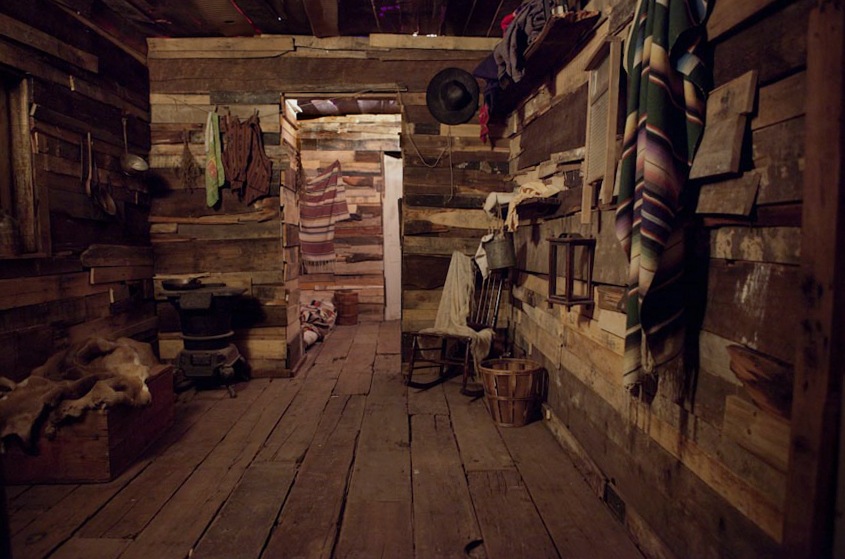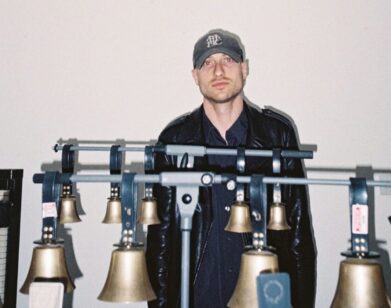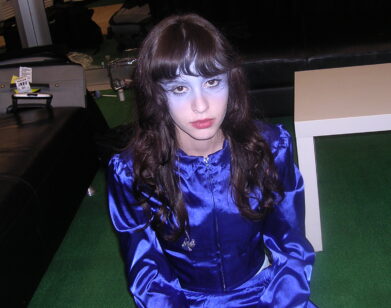Javelin and Mike Anderson Dream Westward

ABOVE: CANYON CANDY AT CLOCKTOWER GALLERY.
“We spent the summer in Bushwick listening to Slim Whitman records slowed down,” recalls Tom Van Buskirk of the band Javelin. He was describing the moment about two-and-a-half years ago when he really began to love country music. At the time, he and bandmate George Langford were living in New York City, making dance music. Months later, they would embark on a six-month tour through the South and the West, which would inspire their country-western album, Canyon Candy.
On the road, Van Buskirk, 30, and Langford, 32, who also happen to be cousins, began imagining making their own Western Songbook album, after noticing a series of poetic signs for state and national parks, like “Crater of Diamonds.” They sounded like song titles.
Until that point, Van Buskirk and Langford had been known for their nuanced and whimsical pop confections, which combine original compositions with found sounds to create music that hopscotches through a wide range of eras and genres. “We were inspired by the open spaces, but also craving different sounds,” says Langford. For both members of Javelin, the prospect of making a country album felt ambitious—”not in the way of a slam-dunk, alley-oop situation,” says Van Buskirk. “But this was more of an experiment than anything we had ever done. We always tried to do everything at once. It was experimental for us to work with a more conventional form.” For both musicians, country music has a distinct allure. “It’s about being real—it’s really emotional, but it’s also very straightforward about its emotion,” Van Buskirk explains. “And the kind of country music that I like is the blues that white people were singing in the middle of the century, life-is-hard kind of stuff.”
The pair worked like Method actors, immersing themselves in the genre by searching for the kind of dollar-bin country-western albums that had been hastily assembled to capitalize on the midcentury popularity of cowboy music. “I had the feeling I was mining someone else’s nostalgia,” says Langford, of finding music by the Sons of the Pioneers, the popular country-western vocal group that first emerged during the Depression in the 1930s—Western movie star and singer Roy Rogers was a founding member—and remained popular through the 1960s. “You’re holding the record and you have a sense of what the aesthetic is before you even listen to it: maybe a dozen male tenor voices and big thunderous choruses.”
Playing instruments that include fingerpicked guitar, mandolin, jaw-harp, harmonica, and drum machines, they began creating their own otherworldly cowboy music.
“George was working on cut-ups, collages of one specific song, and then he did a couple songs like “Love Gulch,” that have barely any samples at all,” says Van Buskirk. “I made a track with my friend David, who I was living with at the time. We wrote this song ‘Streets of Laredo.’ We recorded it all ourselves to tape and then slowed it down, the way the records that we like were slowed down.”
Last April, they released that album, Canyon Candy, via David Byrne’s world music label Luaka Bop. It now has companion pieces in the form of a short film and an art installation at New York’s Clocktower Gallery, which Javelin collaborated on with filmmaker Mike Anderson. The installation transports the viewer into the landscape of the film, starting in a cabin and leading out into the open sky. In the midst of termite hills, sand, coyotes, and cactus flowers, a collage of nature sounds and other ambient noises swirl around. The final stop is a saloon-style theater where the film screens. The hallucinatory art film, which Anderson wrote and directed, is filled with symbolic images and archetypal characters.
The film adaptation was a matter of happenstance. In summer 2010, Langford learned that Anderson was interested in making a Western-themed installation, and the three artists had a brainstorming session about making a film together. “Basically everything that pins the film together, we came up with in one conversation,” says Van Buskirk. “Mike wanted a slaughter. I thought there should be the Stranger, a character who’s not involved in any of the action, but who keeps having premonitions of what he’s meant to do, which is to save this girl’s life. It was amazing to me that everything that we talked about pretty much ended up in there.”
For this project, Anderson, 33, wanted to communicate through images, rather than through a straightforward narrative, and the three artists agreed they didn’t want the film to include tidy plot resolutions or a forced unification of themes. “I was really interested in creating a poem, basically,” says Anderson, who majored in painting at the Rhode Island School of Design. In the film, which is silent except for Javelin’s soundtrack and score, Anderson fuses the visual language of dreams with that of the Western. (About half of the film’s music came from Javelin’s album; Van Buskirk and Langford scored the other half.) The story that Canyon Candy tells isn’t complicated—a girl in the Old West becomes the lone survivor of a massacre—but its visual language is.
For all three artists, the appeal of Western films and Western-themed music lies largely in its status as folklore. “When I look at Roy Rogers, he really doesn’t remind me of a real cowboy,” Anderson says. “It’s such a strange representation—it seems to me that in old Westerns, they just made up this completely mythic world.”
For Anderson—whose ancestors had been cattle ranchers in Oregon, and whose grandfather, uncles, and aunt would sing Sons of the Pioneers songs when he was growing up—the Western mythos was particularly appealing. “I was totally raised on the music and this almost dandified version of the West,” he says. “Secretly, the project is almost an homage to that.”
Anderson had first distinguished himself as a filmmaker several years ago, while working out of rural Arkansas. Inspired by artist Raymond Pettibon, he made ultra low-budget video posters for bands that made green-screen special effects look magical. “That’s his strength and the thing that’s easy to dazzle people with,” Van Buskirk observes. But for this project, all three artists wanted to go beyond their established methods of creation.
Even with the help of patrons from the funding site Kickstarter, making the movie—which includes painted backdrops of the desert, an ornate blooming papier-mâché flower, and dioramas—was an exercise in ingenuity. It was, Anderson says, the first Western of its kind to be shot in the New York metropolitan area in more than 100 years for a reason. “We had to make sunsets,” he recalls. “We couldn’t have horses. And we shot [on a soundstage] in Sunset Park [Brooklyn] in an old army terminal.” The 16-minute film also features title cards, as well as the inclusion of a historical character—”a dubious move,” according to Anderson, that was inspired by Cormac McCarthy’s “terribly violent and beautiful” novel Blood Meridian.
Anderson had collaborated with Javelin before, directing a video poster for a musical showcase that featured a lost person sailing on the oceans of the moon in a wooden rowboat, and another video poster, in which alien-looking gods, shown in photographic negative, dance on Mount Olympus. He also made a video for the release of Javelin’s full-length debut album, No Más, which shows both the real and the spirit worlds of two subway passengers to great comic effect. Their new film shows both members of Javelin as messengers in a dream sequence, flowers blooming out of a man’s chest as in medieval etchings, and a strangely beautiful vision of death.
“I was just thinking how someone might foresee his own death,” Anderson says of an arresting dance sequence in the film. “How would death come to you? It might come in a beautiful and almost confusing way.”
For both members of Javelin and Anderson, it’s a shared focus on the notion of discovery and the fact that they come into these projects with knowledge of other fields—Van Buskirk and Langford were English majors, at Brown University and Skidmore College, respectively; Anderson discovered filmmaking only three weeks before college graduation—that has shaped their perspectives. Canyon Candy deals with death and destruction, but in its final moments, it imparts a hopeful message as a flower blooms before the viewer’s eyes. It’s an image of spiritual power that confronts the mysteries of life. These artists’ rainbow of activity this past year was made possible in part by their indirect paths. One reason that Canyon Candy resonates in all its iterations is because the odyssey of the cowboy or frontiersperson also acts as a metaphor for the journey of life.
CANYON CANDY IS ON VIEW AT CLOCKTOWER GALLERY THROUGH MARCH 1.






